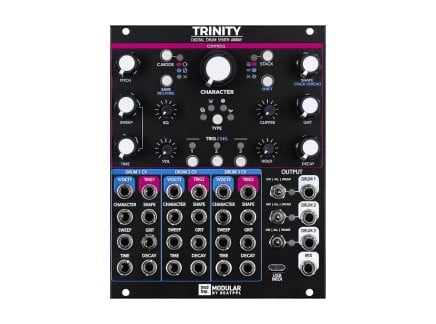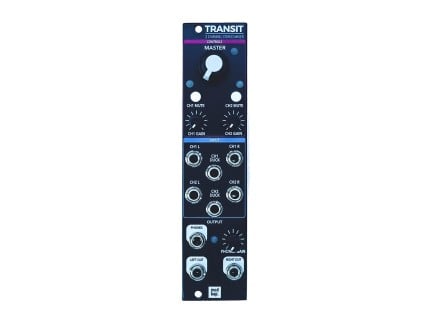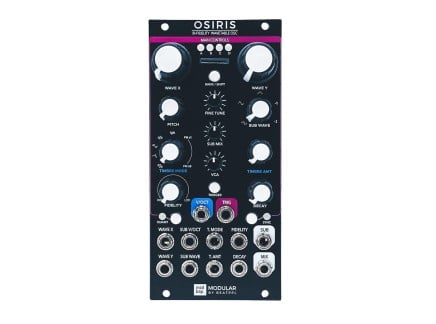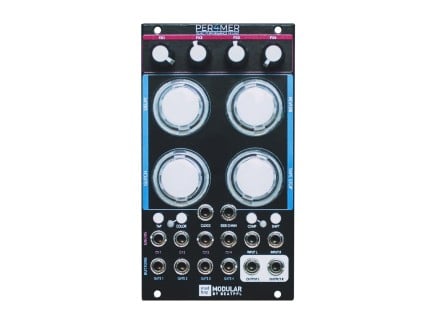Modbap Modular has been up and running since 2020—and ever since, they've been constantly producing some of the most interesting devices out there for modular synthesizer boombap and more. Focused on translating concepts from drum machine and sampler-centric production workflows into the Eurorack modular synthesizer context, they've already produced some of the most interesting and performable modules currently available.
Their first entry into the Eurorack sphere was Per4mer—a performative quad effect processor module based on the effect workflow from the Roland SP-404 and all of its variants. It allows for easy, on-the-fly addition of effects via four arcade buttons and associated parameter controls, for everything from tape stop and glitchy beat repeat effects to classic delay and reverb. Their Transit combines stereo mixing and sidechaining functionality into a powerful output module, while Osiris, their "bi-fidelity" wavetable oscillator enables the creation of everything from glassy arps to gritty bass lines and more.
More recently, though, Modbap has introduced two particularly interesting modules: Trinity, a triple drum voice module, and Hue, an audio coloration processor. Corry Banks (founder of Modbap Modular) recently came by our shop to show off all of his creations, with a special focus on these two modules in particular—so check out the video above to hear about them in his own words, and read on for some of our thoughts about these stellar modules.
Exploring Modbap Modular's Trinity + Hue
Modbap's Trinity is a three-channel "Digital Drum Synth Array"—in short, a three-voice multi-mode drum module capable of everything from classic kicks, snares, and hats, all the way to experimental digital glitches and noise. Optimized for use as part of a modular drum machine, Trinity provides all the sound-making tools you need to create full kits worth of sound.
Each of Trinity's three channels can be set up to use any of its drum synth algorithms, of which there are four. The Block algorithm is inspired by classic analog drum synthesis techniques, great for creating traditional electronic drum sounds. The Heap algorithm is an additive drum synthesizer structure with twelve partials—good for sounds with rich harmonic content like bells, chimes, wood blocks, and more. Neon provides an FM-based approach to drum synthesis, ideal for trashy metallic percussion and growling FM sweeps. Finally, Arcade takes inspiration from '80s video game consoles, creating a digital noise synthesizer great for arcade sounds and lo-fi digital blasts.
By pressing and holding the Trig/Sel buttons, you can define settings for each individual channel—providing basic settings for their pitch, sweep/time (for an Attack-Decay envelope linked to pitch), shape, grit, and decay (for the amplitude envelope). You might immediately think that not having simultaneous access to these parameters on a per channel basis might be a downside, however, you do have access to CV inputs for each of these parameters on each channel, in addition to the per-channel 1V/Oct Pitch CV and Trigger inputs. So, when paired with the right sequencer or CV source, you can do all sorts of tricks to add life and motion to your sound.
There's much more to Trinity than just that, of course. It features per-channel tilt EQ, Volume control knob, Clipper (a simple waveshaper), and Hold (for the amplitude envelope) controls, great for fine-tuning each channel's sound. It also includes a flexible output routing matrix, making it possible to access individual outputs, submixes, and more—great for parallel processing, sidechaining, etc. You can create stacks of channels for layered drum tones...heck, you can also switch between drum synth algorithms sequentially on a per-channel basis, or can create a new random drum sound with each incoming trigger. Trinity also allows for MIDI over USB, great for parameter control and more. In short, if you're looking for a highly flexible multi-voice drum synth for your Eurorack system, Trinity might be just the thing: just add triggers and CV and you're good to go.
As Corry points out in the video above, though, there's a lot more at work behind our favorite classic drum synth sounds than the drum machines themselves. Often, on our favorite records, we're hearing the sounds of the drum machine through consoles, tape machines, multiple passes of analog to digital and digital to analog conversion, etc....and the subtle details in each stage of translation can really add up to define the sound of a piece of music. That's why Modbap makes Hue, a "color processor" intended to provide end-of-chain style effects that model the nostalgic, lo-fi sounds of boombap production.
He's quick to point out that Hue doesn't replace the sound of a console or tape machine, instead taking inspiration from mixing/mastering processes and their related artifacts in order to create a playable effect processor. Where Per4mer provides access to drastic, dramatic effects, Hue instead focuses on subtler processing. Specifically, it is comprised of a chain of five simultaneous effects, each with their own style of coloration: a Filter, a Drive, Tape Saturation, LoFi processor, and a Compressor.
The Filter is a DJ mixer-style tilt EQ, with lowpass filtering to the left, highpass filtering to the right, and no filtering at 12:00. This is a one-knob way of easily creating drastic tonal changes—helping to provide shape and direction for your performances. The Drive is a variable distortion, and Tape is a tape saturation processor designed for subtle saturation and the introduction of simple, non-destructive tape artifacts. The LoFi processor allows you to control sample rate and bit depth, great for everything from subtle classic groovebox tones to more drastically downsampled/bitcrushed textures. Lastly, a one-knob compressor ties everything together, giving you easy access to dynamic swells and pumping textures.
In addition to the front-panel knobs and Shift functions, you also have CV inputs for the Drive, Filter, Tape, and LoFI parameters, making Hue every bit as playable as Trinity. It is worth noting, however, that Hue has only mono audio input and output—so for full stereo processing, you might just have to grab two.
Together? Trinity and Hue provide a huge range of sonic potential with an insane degree of CV-connectivity, forming a drum synth/audio coloration combo capable of everything from classic lo-fi tones to intricate, animated, as-of-yet unheard sounds.
Modbap Modular: Classic and Future Sounds Combined
Modbap continues to push boundaries, providing accessible, flexible, and fun ways to bring hip-hop and boombap production and performance techniques to Eurorack modular synthesizers. They're covering ground seldom approached by other makers—and they're bringing the process of beat production to a more open-ended, experimental format than ever before.
But what's truly great is that, while they clearly take inspiration from classic beat machine-based workflows, they're always taking them a step further: complete with CV control, edgy sound design, and refined user interfaces that make it easy and fun to play your synthesizer system, and to make sounds both familiar and unfamiliar. Looking for a way to approach your synthesizer like a modular drum synth/groovebox with a classic lo-fi hip-hop/boombap vibe? Modbap has you covered.


















